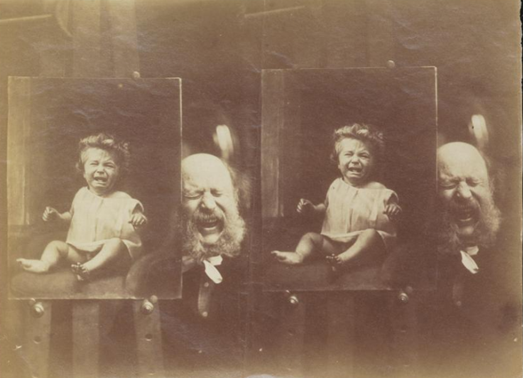Darwin’s interest in emotions can be traced as far back as the Beagle voyage. He was fascinated by the sounds and gestures of the peoples of Tierra del Fuego. On his return, he started recording observations in a set of notebooks, later labelled 'Metaphysics on Morals & Speculations on Expression'. Details about the facial and bodily movements accompanying various emotions were entered, alongside remarks on the origins of language, aesthetic taste, and sympathy, comparing the behaviour of humans and animals. At the same time (1839), he embarked on a detailed study of his first child William in early stages of development. Darwin was not a passive observer, but actively provoked emotional responses by raising his voice, poking or prodding the boy, hiding toys, and withholding affection temporarily at moments of distress. ‘I made a loud snoring noise, near his face,’ Darwin remarked, ‘which made him look grave & afraid & then suddenly burst out crying. This is curious … I repeated the experiment’ (‘Observations of children’, Correspondence vol. 4, Appendix III, p. 415).
Darwin’s study of emotional expression extended over thirty years, culminating in his 1872 book on the subject. At first glance, the book seems less ‘scientific’ than his other works. It is filled with examples from novels, plays, and the visual arts, with anecdotes about devoted dogs, pouting children, and sulky chimps. But the book was extremely innovative in its methods and source material. To document and display expressions, Darwin made extensive use of a relatively new technology: photography. He commissioned work from studio artists and incorporated imagery of physiological experiments on facial movement. This interest in physiology would mark much of Darwin’s later work, including his botanical studies. Expression drew extensively on experiments on the reflex action of the nervous system. Darwin familiarized himself with this research through reading, but he also began correspondence with leading physiologists in Britain and the continent who conducted experiments on his behalf.
The emotional specimen
In 1871, Darwin contacted the German photographer Adolph Kindermann, ‘I am writing an Essay on the Ex. of the emotions … I shd be very glad if you could make for me a photograph of an infant, only a month or two old, whilst screaming with the eyes firmly closed, adjusting the focus for the eyes, so as to show the wrinkles round them’ (letter to A. D. Kindermann, [27 March 1871]). Darwin had begun collecting photographs on expression in the early 1860s, and built up a collection of several hundred images. His pattern of collecting suggests that he regarded the photographs as natural history specimens. He arranged them according to different classes, and drew comparisons across human groups and the animal-human boundary. Many of these were child character studies, which were popular at the time and widely sold by commercial photographers.
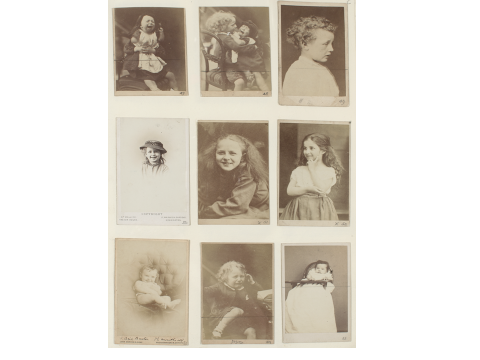
DAR 51, Cambridge University Library
Darwin’s interest in photographs was largely methodological. In the introduction to Expression, he remarked on the difficulty of studying emotions that provoked sympathy in the observer, adding ‘I have found photographs made by the instantaneous process the best means for observation, as allowing more deliberation’ (p. 149). Photographs established distance from the face-to-face encounter, depersonalizing observation. They also fixed movement, prompted memory, and kept wayward imagination in check. But what Darwin described as the ‘instantaneous process’ was in fact an artful contrivance of skilled photographers, who were able to alter the print in order to give the appearance of an expressive movement frozen in time. Camera exposures were still several seconds at a minimum, and so catching a baby crying was virtually impossible without studio interventions. After over a year of searching, Darwin finally obtained a screaming baby in the spring of 1872 from the London photographer, Oscar Rejlander, who was famous for his sentimental portraits of ragged children. The particular baby displayed in Expression had been one of Rejlander’s greatest commercial successes, with some quarter of a million copies sold in three years.

‘Ginx’s’ baby
The insertion of such sentimental material into the text re-introduced the problem of sympathy, and Darwin devised several strategies for managing the emotions of Victorian readers. In order to present an expression in the manner of a natural history specimen, Darwin displayed a series of portraits on a single plate. The printing process that enabled photographs to be mass‐produced was quite new, and the plates for Expression were extremely difficult in their preparation and delayed publication for many months. Expression included seven plates, most containing multiple images of a single expression.
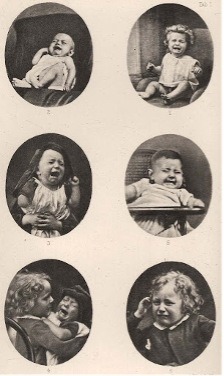
Here the baby ('Ginx') appeared in the top right corner together with five others in mid-scream, in order to illustrate the violent contraction of the eye-muscles. Such composite images could divest photographs of their sentimental power and halt the flow of sympathy. With six babies on a plate, it was more difficult for readers to linger over the grief-stricken children individually, as a parent might dote upon a child. They were instead directed to compare particular features, such as the shape of the mouth and furrows of the brow.
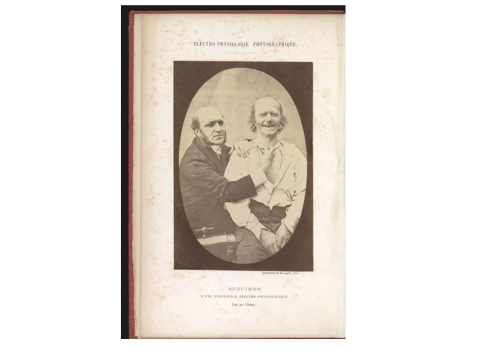
Frontispiece: Duchenne 1862. Mécanisme de la physionomie humaine
Darwin was particularly interested in photographs produced by the French physiologist, Guillaume Benjamin Duchenne, who used a galvanic process to produce facial movements artificially. Duchenne’s favourite subject was an old shoemaker (shown above), whose face was insensitive, making it possible to apply the electrical probes for extended periods. The method was extremely effective in isolating certain muscles that were not under the control of the will, such as the platysma myiodes of the neck, prominent in extreme fear. But the apparatus of experiment, especially the presence of the doctor and his horror-inducing probes, did not fit easily in Darwin’s framework of natural historical study. It also posed new problems for the sympathetic observer (Darwin’s readers). Of all the photographs that Darwin used in Expression, Duchenne’s are the only ones that were substantially altered. Several photographs, including the one of terror, were reproduced as woodcuts with the electrodes removed.
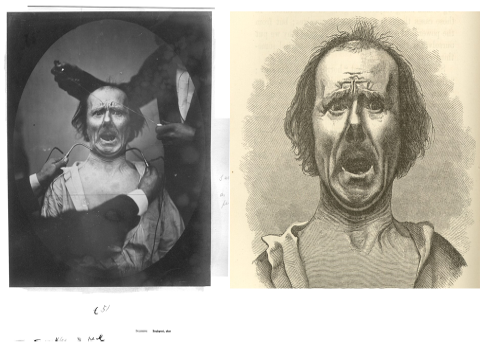
Photograph from Duchenne’s folio Album and engraving of the same from Expression
Reflex physiology
In the first three chapters, Darwin presented his explanatory principles of expression: serviceable associated habits, antithesis, and the direct action of the nervous system. Habit and association were closely linked with reflex action. The bonds between thought, feeling and muscle movement were neural pathways, carved out by frequency of use. ‘Antithetical’ expressions, such as the fallen features of sadness, were also reflexive in nature. Finally, Darwin attributed many of the small movements of expression, tiny twitches around the mouth and nose, the back-bone shiver, jitteriness, scratching one’s head, grinding one’s teeth, as bi-products of the overflow of current at moments of nervous excitement and discharge. His whole explanatory framework was built upon theories of reflex action, and the extension of the reflex arc to the mind and brain.
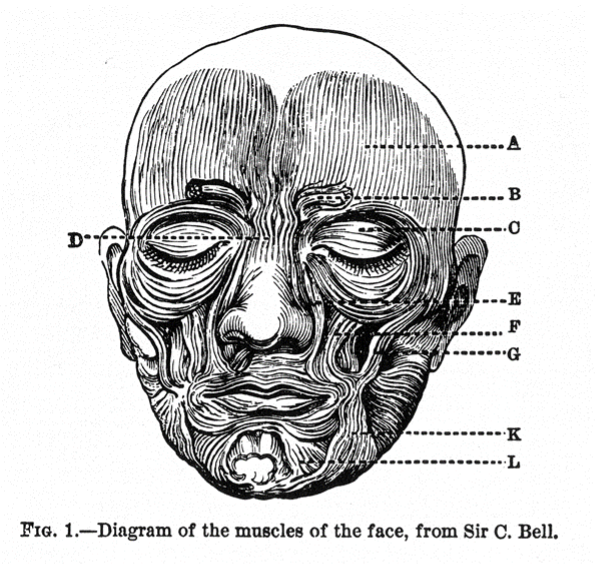
For reasons we will consider in a later section, Darwin never performed the kinds of experiments, mostly on live animals, that underpinned the physiology of reflexes. Nor did he describe them in Expression. Instead, he cited leading physiologists such as Johannes Müller, Claude Bernard, and William Carpenter, as well as theorists and philosophers of mind and body like Herbert Spencer and Alexander Bain. Darwin did not just read himself into physiology, however. In the late 1860s, he began to build a new network of correspondents. One of his first contacts was William Bowman, an eminent ophthalmic surgeon. Darwin wanted to establish which nerves were involved in contracting the eye muscles during weeping, and to what degree the process was under voluntary control. He asked Bowman, “Does the same nerve which runs to the orbicularis send off fibrils to the lachrymal glands, & if so, when the order goes for the muscle to contract is nervous force sent sympathetically at the same time to the glands?” (letter to William Bowman, 30 March [1868]).
Bowman was unable to provide answers, but he put Darwin in touch with another expert, Frans Donders. At Darwin’s behest, the Dutch specialist undertook painstaking experiments to isolate the specific nerve fibres responsible for tear secretion. After several years, Donders eventually sent a 16 page letter containing a digest of his experiments on rabbits, their brains exposed to reveal the effect of respiratory movements on dilation, allowing the physiologist to trace the vessels in the eye to the cranium, and follow the nerve pathways from the lachrymal gland to the medula oblongata, the main centre of reflex action, and the cerebrum, the seat of thought and volition (letter from Frans Donders, 28 May 1870). The orbicular muscles and lachrymal gland were thus governed by a complex system of voluntary and involuntary nerves. Darwin incorporated the detailed physiological explanation into his text, where it appeared alongside the portraits of weeping babies, and other photographs, showing the expression of grief.
Another expression that puzzled Darwin was blushing. Many of the situations (embarrassment, shame) in which blood suddenly rushed to the face, seemed to require mental power (self-consciousness, imagination, memory). But how could the mind operate on the body, especially a process like blood flow, which seemed entirely beyond voluntary control? Darwin consulted another leading physiologist, Michael Foster, who had been appointed to the first post devoted exclusively to physiology at Cambridge. Again, Darwin’s questions pushed the boundaries of physiological knowledge. When asked about the dilation of blood vessels in the face, and the possible effect of mental attention on blood flow, Foster was embarrassed by his ignorance: “I am perfectly ashamed to say that I send off by this post an attempt to answer your questions”. In a very long letter, he made his best guess, summarizing his view at the end: “The direction of the attention gives rise to certain ideas, emotions or similar processes connected to a certain extent with the function of the organ [in this case, the face]. These ideas &c &c probably form part of a long series of processes which ultimately come to bear on the vaso-motor centres with which they have a distinct physiological (possibly anatomical) relation” (letter from Michael Foster, 4 June [1871]).
Making experiments familiar
Unlike many of Darwin’s evolutionary publications, Expression was clearly written for a more general audience. Reviewers commented on its ‘popular’ nature, and enjoyed the animal stories and photos of babies and children. The text did contain many minute descriptions of muscle movements and nerve activity, but Darwin only reported the results of experiments, not the laboratory procedures behind them. His choice of photographs and editing of imagery removed some of the invasive and potentially unsettling features of experimental physiology. He also familiarized the process of experimentation, calling upon readers to become witnesses and studied observers themselves. He invited them to conduct experiments at home, as he had done on his own children: 'make a person first raise his eyebrows … and then very gradually contract all the muscles round the eyes with as much force as possible' (Expression, p. 147).

Draft table of answers to expression questions, March-November 1868, DAR 186: 27, Cambridge University Library
Active witnessing, reflection and assessment featured in other ways in the book. Darwin reported that he had shown a number of Duchenne’s photos to guests at Down House, asking them to identify which emotion was being expressed (see Expression, p. 181). Duchenne’s method of producing expressions through electrical stimulation (rather than inner feeling) raised questions about authenticity. Darwin described the verification process to James Crichton-Browne, who used photography in his Asylum at West Riding: ‘I have shown the most characteristic [photos] (hiding any indication of what they were meant to express) to between 20 and 30 persons of all kinds, and have recorded their answers: when nearly all agree in their answer, I trust him’ (letter to James Crichton Browne, 8 June 1870). The practice of witnessing had long been a part of the ‘proof’ or legitimation of experiments, from the early days of the Royal Society. Here, the process seems to return us to the operation of sympathy. The true meaning of the expression is registered by the feelings produced in the observer.
See more about Darwins' research on Expression of emotions

